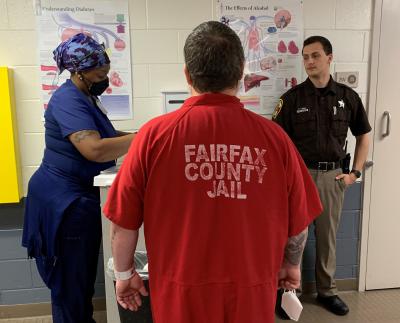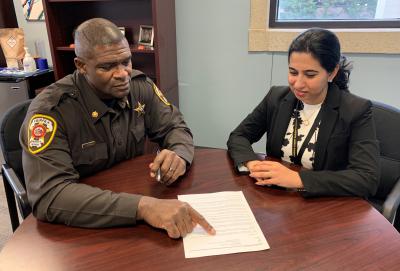“In the Fairfax County Adult Detention Center, our goal is to assist incarcerated men and women leading up to their release from the jail and set them up to successfully reintegrate into the community.”
Sahana Karpoor, LCSW, Behavioral Health/MAT Program Manager
Fairfax County Sheriff’s Office
October 25, 2022

In the operation of its Adult Detention Center (ADC), the Fairfax County Sheriff’s Office offers Medication for Addiction Treatment (MAT) for inmates with opioid use disorder (OUD). OUD is a chronic but treatable health condition similar to diabetes, heart disease or asthma. With the MAT program, the Sheriff’s Office has not only made it a priority to offer evidenced-based treatment for individuals with OUD while they are incarcerated but also to ensure wraparound reentry recovery supports at release.
In FY 2022, the Sheriff’s Office had 805 inmates engaged in MAT services.
As these incarcerated men and women prepare to leave the ADC, the Sheriff’s Office – in partnership with the jail-based Community Services Board (CSB) team and the Chris Atwood Foundation (CAF) – links them with recovery housing, 12-step programs such as Narcotics Anonymous, wellness programs, and a MAT provider in the community.
To increase the chances for success on the challenging path to recovery, the Sheriff’s Office gives participants bridge doses of OUD medications to cover them until they are able to connect with a community provider. Additionally, participants are given a free cell phone with a fixed number of minutes and the capability for the CSB Addiction Medicine Clinic (AMC) to add more minutes. This cell phone helps them connect with community-based recovery supports. The Sheriff’s Office reentry program recognizes transportation as one of the challenges for continued success and immediately sets up transportation to a MAT clinic and recovery housing, as needed. Before participants leave the jail, the reentry coordinator also can assist them with obtaining legal identification and starting the Medicaid application/eligibility process.

“We meet clients where they are and recognize that they may have setbacks,” says Sahana Karpoor, the Sheriff’s Office MAT program manager. “Harm reduction is very important. We not only educate them on how to seek treatment for OUD but also provide Narcan and show them how to use it to reverse a potential opioid overdose.”
A 2018 study by the University of North Carolina-Chapel Hill, NC Division of Public Health and NC Department of Public Safety found that former inmates were 40 times more likely to die of an opioid overdose in the first two weeks after release than a person in the general public. Looking at only heroin overdoses, former inmates were 74 times more likely in the first two weeks to die from an overdose.
Karpoor sites a 2022 research paper from Tufts University School of Medicine and University of Massachusetts on MOUD programs that identifies three key areas for a successful jail to community transition: bridge dosing, better communication and phone access. Early in its program, the Sheriff’s Office incorporated these three transition elements. “This study validates our proactive, innovative efforts to address the opioid epidemic, and we hope other jails in Virginia will follow our lead.”
Karpoor says Fairfax County is lucky to have Sheriff Stacey Kincaid as a champion of MOUD. “All the services we provide are aimed at improving the chances that our clients will enjoy a healthy and productive lifetime in recovery,” adds Karpoor. “As a result, we will eliminate overdose deaths, the recidivism rate will drop, and our community will be healthier and safer for everyone.”
Carlos has been in the ADC MAT program for about four months. At first, he was hesitant about MAT because he did not want to trade one drug for another. After a nurse practitioner explained how MAT works, he was on board, calling buprenorphine a lifesaving, miracle drug. “When I get out of jail, I will continue on MAT and a 12-step program,” says Carlos. “I don’t think I will ever use drugs again.” He wants to live at an Oxford House and work as a peer recovery specialist. “I’ve always worked in customer service. Helping people was my job, so that’s what I want to do again, to help others with their recovery.”
For more information about the Fairfax County Sheriff’s Office MAT/MOUD programs, please contact Sahana Karpoor at sheriff@fairfaxcounty.gov.

